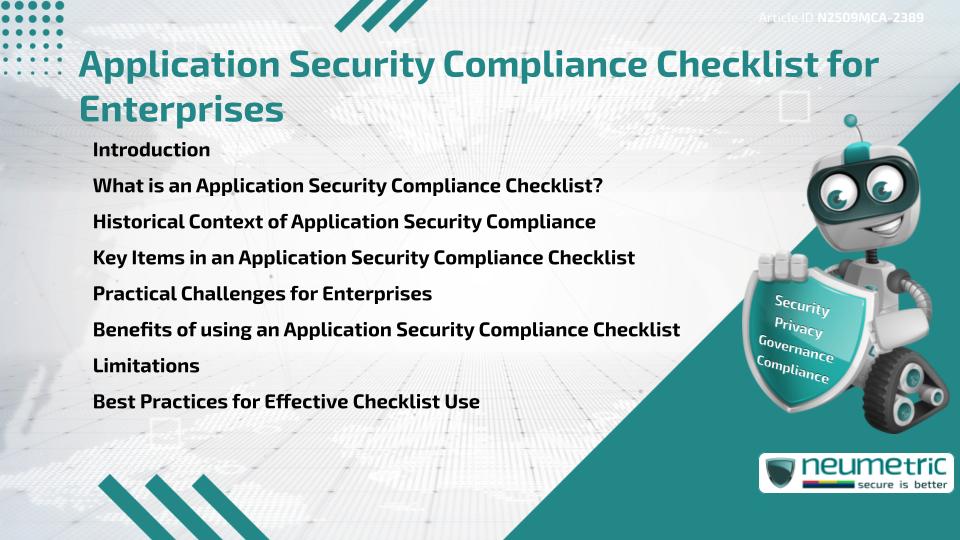Table of Contents
ToggleIntroduction
An Application Security Compliance Checklist is a valuable Tool for Enterprises seeking to protect Software & Data from Vulnerabilities. As Applications form the backbone of modern businesses, weak Security can lead to Breaches, Penalties & Reputational damage. A Compliance Checklist ensures that Applications align with Regulatory Requirements & Industry Standards, reducing Risks while improving trust.
What is an Application Security Compliance Checklist?
An Application Security Compliance Checklist is a Structured set of Requirements & Best Practices used to evaluate whether Applications meet Security & Regulatory expectations. It typically references Frameworks such as NIST, ISO 27001 & OWASP. By following the Checklist, Enterprises can Systematically review Security Controls across Development, Deployment & Maintenance Stages.
Historical Context of Application Security Compliance
In the early days of Software, Security was often an afterthought. Many Breaches stemmed from Coding flaws, Misconfigurations or Inadequate Testing. As incidents grew, Industry groups such as OWASP introduced Structured guidance. Regulators later embedded Application Security requirements into Compliance Frameworks, making Checklists a Standard Tool for Governance.
Key Items in an Application Security Compliance Checklist
A comprehensive Checklist should include:
- Secure Coding Practices: Ensure developers follow Standards to avoid Vulnerabilities.
- Authentication & Access Control: Apply Least Privilege & Multi-factor Authentication.
- Data Protection: Encrypt Sensitive Data In Transit & At Rest.
- Vulnerability Scanning: Perform regular Scans for known Threats.
- Patch Management: Apply updates to Libraries, Frameworks & Systems.
- Incident Response: Define & Test procedures for handling Application-level Breaches.
- Audit Logging: Maintain Records of User Activities & System changes.
Practical Challenges for Enterprises
Using an Application Security Compliance Checklist can be challenging. Large Enterprises may manage hundreds of Applications across diverse environments, making consistent Compliance difficult. Legacy Applications often lack modern Security Features, while Resource constraints can delay Patching or Remediation. Coordinating Security efforts across Development, Operations & Compliance Teams also requires cultural alignment.
Benefits of using an Application Security Compliance Checklist
Despite challenges, the Checklist provides multiple benefits:
- Reduced Risk of Breaches & Data Leaks
- Stronger alignment with Regulations such as GDPR, HIPAA & PCI DSS
- Improved efficiency through Standardised Security Reviews
- Greater trust from Customers, Regulators & Partners
- Enhanced resilience through proactive Risk Management
Limitations
Some critics argue that Checklists may create a “Box-ticking” culture rather than fostering real Security improvements. Others note that strict Compliance can slow down Agile Development. Additionally, a Checklist cannot cover every evolving Threat, so continuous updates are necessary.
Best Practices for Effective Checklist Use
To maximise effectiveness, Enterprises should:
- Tailor the Checklist to Organisational & Regulatory requirements
- Automate scanning & reporting wherever possible
- Conduct regular Training for Developers & Security Staff
- Align practices with Global Resources such as OECD, World Bank & ENISA
- Integrate the Checklist into DevSecOps workflows for Continuous Compliance
Takeaways
An Application Security Compliance Checklist is more than a Governance Tool, it is a Roadmap for protecting Critical Software Assets. By implementing Structured reviews & aligning with Global Standards, Enterprises can reduce Risks, ensure Compliance & Strengthen trust.
FAQ
What is an Application Security Compliance Checklist?
It is a Structured set of requirements to ensure Applications meet Security & Regulatory expectations.
Why is it important for Enterprises?
It reduces Vulnerabilities, prevents Breaches & Ensures Regulatory alignment.
What challenges do Enterprises face?
Challenges include managing Legacy Systems, Resource constraints & Cultural alignment.
What are the key Checklist items?
Secure Coding, Access Control, Encryption, Vulnerability Scanning, Patching, Incident Response & Audit Logging.
Does a Checklist guarantee full protection?
No, but it significantly reduces Risks & Improves Compliance when regularly updated.
References
- NIST CyberSecurity Framework
- ISO 27001 – Information Security
- OWASP Foundation
- OECD Privacy Guidelines
- ENISA – European Union Agency for CyberSecurity
Need help for Security, Privacy, Governance & VAPT?
Neumetric provides organisations the necessary help to achieve their CyberSecurity, Compliance, Governance, Privacy, Certifications & Pentesting needs.
Organisations & Businesses, specifically those which provide SaaS & AI Solutions in the Fintech, BFSI & other regulated sectors, usually need a CyberSecurity Partner for meeting & maintaining the ongoing Security & Privacy needs & requirements of their Enterprise Clients & Privacy conscious Customers.
SOC 2, ISO 27001, ISO 42001, NIST, HIPAA, HECVAT, EU GDPR are some of the Frameworks that are served by Fusion – a SaaS, multimodular, multitenant, centralised, automated, CyberSecurity & Compliance Management system.
Neumetric also provides Expert Services for technical Security which covers VAPT for Web Applications, APIs, iOS & Android Mobile Apps, Security Testing for AWS & other Cloud Environments & Cloud Infrastructure & other similar scopes.
Reach out to us by Email or filling out the Contact Form…





